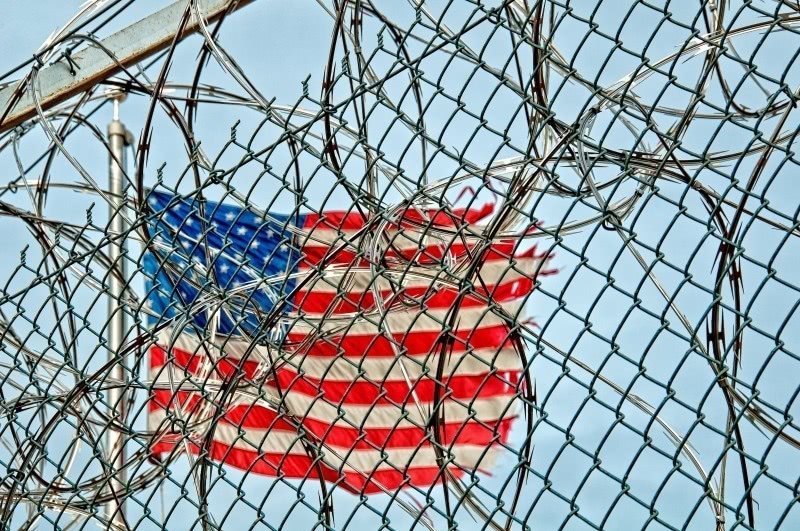Jails and prisons are the next “country” to get COVID-19, with the infection timeline trailing America’s. It will be a much steeper graph, and far more deadly. On March 28, Patrick Jones in Louisiana became the first person in the federal prison system to die of the virus.
As advocates tangle with Congressmembers, governors, district attorneys and prison directors to reduce the jail and prison populations, a key voice is left out: people on lockdown inside cramped facilities. While some districts ease crowding through issuing citations instead of arrests and releasing people held on low-level offenses, millions more are left inside.
Prison is an extremely stressful environment, as I know from my own 12 years of incarceration, and jails even more so. People do not chill out in front of Netflix. Most people are confined with strangers, whether on a bunk bed or in a dorm, sleeping and coughing mere inches from each other. They share toilets, showers, sinks and chow halls.
Some have TVs or radios, while others do not. Some rely on family visits or phone calls to keep their sanity, particularly if a crisis is afoot, yet visitation is now canceled and phones may be limited or exorbitantly expensive.
Now that prison staff have brought in the virus, tensions and anxieties have been elevated.
Medical treatment has never been sufficient for incarcerated people, and prisons are surely last in line for COVID-19 testing and treatment, despite a history as viral hotbeds due to close quarters.
Now that prison staff have brought in the virus, tensions and anxieties have been elevated, my incarcerated contacts tell me. Some people will seek to stay in their cell, surviving off commissary orders. (On March 31, the Bureau of Prisons announced that everyone in the federal system will be confined to cells for two weeks, with exceptions for programs like education and mental health treatment, and use of phones, laundry and showers.) But what happens when their money runs out, or the flow of soups, coffee and stamps is otherwise interrupted?
Prisons are creating quarantine blocks, but those will soon overflow. Some will be too sick to make it to Sick Call, or even to call their family. The people inside should not be expected to stand idly by in the face of what they see as injustice, or flat-out torture. People outside will do whatever it takes to get help for themselves or their loved ones. Behind the walls is no different, particularly if a beloved elder in the prison gets sick, rather than released.
Here in Louisiana, the prison capital of the world, new reports of cases among staff and incarcerated people come in by the day. Patrick Jones in FCI Oakdale was listed in “critical condition,” along with others hospitalized, but the authorities did not provide his name to attorneys until he died. Angola State Penitentiary, home of the oldest and least healthy 6,000 incarcerated men in the nation, is poised to host a quarantine colony for the entire state.
A lawsuit, Lewis vs. Cain, about unconstitutional medical care (or lack of it) in Louisiana prior to this pandemic remains unsettled. If infection and death rates are high in the general community, they will be far higher inside jails and prisons.
Incarcerated people are not likely to sit still and wait idly by for help. Some have given up hope, and are moving towards outrage. Prisoners in Texas are suing—not for monetary damages, but for hand sanitizer and adequate social distancing. Many incarcerated people may decide to no longer work in the kitchen or unload trucks, to limit their exposure. They may refuse to go into their cell until their facility receives masks, sanitizer, ventilators or whatever they believe will help.
Mental health is another aspect of this. Many incarcerated people have preexisting mental health conditions, and collective anxiety is spiking. Some will find out that a family member is intubated at a local hospital, and demand to see them. As prison staff struggle to handle COVID-19 in an underfunded, under-resourced, understaffed setting, they will also experience their own attrition from sickness or stress.
The current veil of secrecy is wrong.
Hurricane Katrina taught us valuable lessons—or should have—about infrastructure, and lack thereof, when a crisis hits. It taught us about resource gaps and priorities. And it taught us about who gets forgotten—particularly when men were left locked inside a local jail in New Orleans without food, water or medicines as the flooding hit.
The current veil of secrecy over who is being quarantined within the system, and what treatment they receive, is wrong. The Office of Public Health in every state needs to immediately launch an investigative team for prison oversight which contains a prisoner advocate, similar to the standards that govern human research studies.
While many in America are contemplating what to binge on Netflix or juggling working from home with their kids, while others want to “open it back up” for business, never forget that there are over two million people sitting in cages—the most highly transmittable spaces in the nation—who are expected to simply Keep Calm and Carry On.
Photo via Foter.com/Public Domain





Show Comments